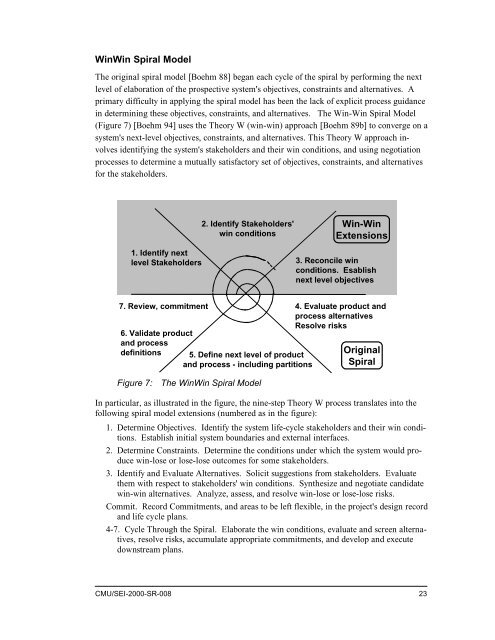00sr008
00sr008
00sr008
You also want an ePaper? Increase the reach of your titles
YUMPU automatically turns print PDFs into web optimized ePapers that Google loves.
WinWin Spiral Model<br />
The original spiral model [Boehm 88] began each cycle of the spiral by performing the next<br />
level of elaboration of the prospective system's objectives, constraints and alternatives. A<br />
primary difficulty in applying the spiral model has been the lack of explicit process guidance<br />
in determining these objectives, constraints, and alternatives. The Win-Win Spiral Model<br />
(Figure 7) [Boehm 94] uses the Theory W (win-win) approach [Boehm 89b] to converge on a<br />
system's next-level objectives, constraints, and alternatives. This Theory W approach involves<br />
identifying the system's stakeholders and their win conditions, and using negotiation<br />
processes to determine a mutually satisfactory set of objectives, constraints, and alternatives<br />
for the stakeholders.<br />
1. Identify next<br />
level Stakeholders<br />
2. Identify Stakeholders'<br />
win conditions<br />
Win-Win<br />
Extensions<br />
3. Reconcile win<br />
conditions. Esablish<br />
next level objectives<br />
7. Review, commitment<br />
6. Validate product<br />
and process<br />
definitions<br />
5. Define next level of product<br />
and process - including partitions<br />
4. Evaluate product and<br />
process alternatives<br />
Resolve risks<br />
Original<br />
Spiral<br />
Figure 7:<br />
The WinWin Spiral Model<br />
In particular, as illustrated in the figure, the nine-step Theory W process translates into the<br />
following spiral model extensions (numbered as in the figure):<br />
1. Determine Objectives. Identify the system life-cycle stakeholders and their win conditions.<br />
Establish initial system boundaries and external interfaces.<br />
2. Determine Constraints. Determine the conditions under which the system would produce<br />
win-lose or lose-lose outcomes for some stakeholders.<br />
3. Identify and Evaluate Alternatives. Solicit suggestions from stakeholders. Evaluate<br />
them with respect to stakeholders' win conditions. Synthesize and negotiate candidate<br />
win-win alternatives. Analyze, assess, and resolve win-lose or lose-lose risks.<br />
Commit. Record Commitments, and areas to be left flexible, in the project's design record<br />
and life cycle plans.<br />
4-7. Cycle Through the Spiral. Elaborate the win conditions, evaluate and screen alternatives,<br />
resolve risks, accumulate appropriate commitments, and develop and execute<br />
downstream plans.<br />
CMU/SEI-2000-SR-008 23














